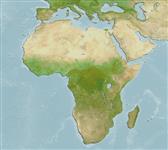Classification / Names
Common names from other countries
Main reference
Size / Weight / Age
Max length : 58.0 cm SL male/unsexed; (Ref. 8954); 42.0 cm SL (female)
Environment
Freshwater; benthopelagic
Climate / Range
Tropical, preferred ?
Distribution
Short description
Anal
spines: 0;
Anal
soft rays: 9 - 12;
Vertebrae: 44 - 49. Diagnosis: large species (Ref. 34006, 78218). Tooth patches broad; obliquely angled pectoral fins positioned low on body (Ref. 44050). 17-49 (Ref. 34006) or 44-45 (Ref. 44050) vertebrae. 9-12 anal-fin rays; 19 caudal-fin rays (ii-7-8-ii); eye typically oval (along horizontal axis); caudal saddle and bar pattern poorly developed, even in juveniles; body with relatively small spots and flecks; pectoral and pelvic fin rays unpigmented (Ref. 44050). Broader mouth than M. microstoma, and fewer gill rakers and more vertebrae than either M. microstoma and M. tanganyikaensis; small dark marks rather uniformly distributed over the entire body and caudal fin, with no distinct dark or pale bars or bands, as M. microstoma and M. tanganyikaensis (Ref. 34006).
IUCN Red List Status (Ref. 115185)
Threat to humans
Harmless
Human uses
Fisheries:
More information
Common namesSynonymsMetabolismPredatorsEcotoxicologyReproductionMaturitySpawningFecundityEggsEgg development
Age/SizeGrowthLength-weightLength-lengthLength-frequenciesMorphometricsMorphologyLarvaeLarval dynamicsRecruitmentAbundance
ReferencesAquacultureAquaculture profileStrainsGeneticsAllele frequenciesHeritabilityDiseasesProcessingMass conversion
Tools
Special reports
Download XML
Internet sources
Estimates of some properties based on models
Phylogenetic diversity index
PD50 = 0.5000 many relatives (e.g. carps) 0.5 - 2.0 few relatives (e.g. lungfishes)
Trophic Level
3.5 ±0.5 se; Based on size and trophs of closest relatives
Resilience
Vulnerability
Moderate to high vulnerability (47 of 100)
Price category
